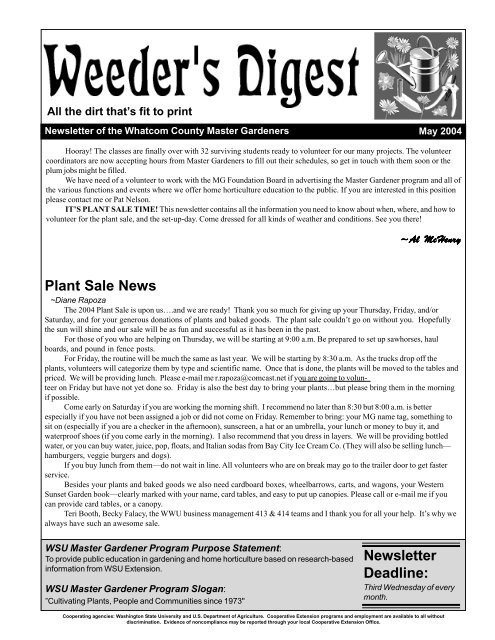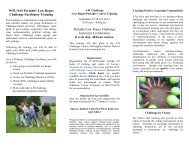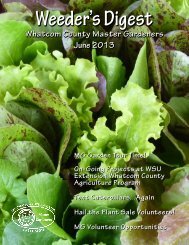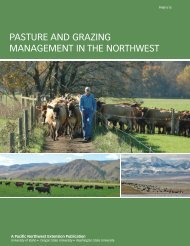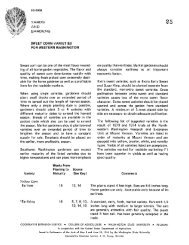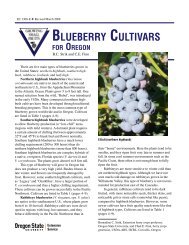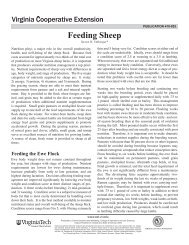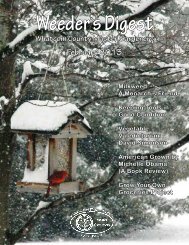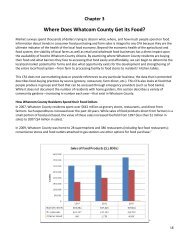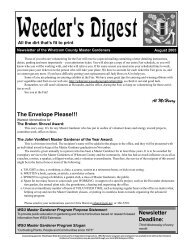May - WSU Whatcom County Extension - Washington State University
May - WSU Whatcom County Extension - Washington State University
May - WSU Whatcom County Extension - Washington State University
- No tags were found...
Create successful ePaper yourself
Turn your PDF publications into a flip-book with our unique Google optimized e-Paper software.
All the dirt that’s fit to printNewsletter of the <strong>Whatcom</strong> <strong>County</strong> Master Gardeners<strong>May</strong> 2004Newsletter of the <strong>Whatcom</strong> <strong>County</strong> Master GardenersHooray! The classes are finally over with 32 surviving students ready to volunteer for our many projects. The volunteercoordinators are now accepting hours from Master Gardeners to fill out their schedules, so get in touch with them soon or theplum jobs might be filled.We have need of a volunteer to work with the MG Foundation Board in advertising the Master Gardener program and all ofthe various functions and events where we offer home horticulture education to the public. If you are interested in this positionplease contact me or Pat Nelson.IT’S PLANT SALE TIME! This newsletter contains all the information you need to know about when, where, and how tovolunteer for the plant sale, and the set-up-day. Come dressed for all kinds of weather and conditions. See you there!~Al McHenryPlant Sale News~Diane RapozaThe 2004 Plant Sale is upon us….and we are ready! Thank you so much for giving up your Thursday, Friday, and/orSaturday, and for your generous donations of plants and baked goods. The plant sale couldn’t go on without you. Hopefullythe sun will shine and our sale will be as fun and successful as it has been in the past.For those of you who are helping on Thursday, we will be starting at 9:00 a.m. Be prepared to set up sawhorses, haulboards, and pound in fence posts.For Friday, the routine will be much the same as last year. We will be starting by 8:30 a.m. As the trucks drop off theplants, volunteers will categorize them by type and scientific name. Once that is done, the plants will be moved to the tables andpriced. We will be providing lunch. Please e-mail me r.rapoza@comcast.net if you are going to volunteeron Friday but have not yet done so. Friday is also the best day to bring your plants…but please bring them in the morningif possible.Come early on Saturday if you are working the morning shift. I recommend no later than 8:30 but 8:00 a.m. is betterespecially if you have not been assigned a job or did not come on Friday. Remember to bring: your MG name tag, something tosit on (especially if you are a checker in the afternoon), sunscreen, a hat or an umbrella, your lunch or money to buy it, andwaterproof shoes (if you come early in the morning). I also recommend that you dress in layers. We will be providing bottledwater, or you can buy water, juice, pop, floats, and Italian sodas from Bay City Ice Cream Co. (They will also be selling lunch—hamburgers, veggie burgers and dogs).If you buy lunch from them—do not wait in line. All volunteers who are on break may go to the trailer door to get fasterservice.Besides your plants and baked goods we also need cardboard boxes, wheelbarrows, carts, and wagons, your WesternSunset Garden book—clearly marked with your name, card tables, and easy to put up canopies. Please call or e-mail me if youcan provide card tables, or a canopy.Teri Booth, Becky Falacy, the WWU business management 413 & 414 teams and I thank you for all your help. It’s why wealways have such an awesome sale.<strong>WSU</strong> Master Gardener Program Purpose <strong>State</strong>ment:To provide public education in gardening and home horticulture based on research-basedinformation from <strong>WSU</strong> <strong>Extension</strong>.<strong>WSU</strong> Master Gardener Program Slogan:”Cultivating Plants, People and Communities since 1973"NewsletterDeadline:Third Wednesday of everymonth.Cooperating agencies: <strong>Washington</strong> <strong>State</strong> <strong>University</strong> and U.S. Department of Agriculture. Cooperative <strong>Extension</strong> programs and employment are available to all withoutdiscrimination. Evidence of noncompliance may be reported through your local Cooperative <strong>Extension</strong> Office.
President’s MessageLinda Bergquist,MGF President<strong>May</strong> 2004When the “season” arrives, Master Gardeners SPRING into action.Pat Nelson, our Volunteer Coordinator has received 100 responses to our “tell us your areas ofinterest” veteran re-application form that was sent to you in the March issue of this newsletter. The formis also available on our website. If you haven’t filled one out please do so and send it to Pat.One reason we became Master Gardeners was to help our community and “we are everywhere.”Thanks to Pat’s “matchmaking” we participated in many areas for the first time.Bill Baldwin spoke to the Hopewell Grange about our Master Gardener program.Kendra Bradford spoke on native plants to the Mount Baker Garden Club.We were asked if we could help at the Lynden Home Show, since they were featuring a new gardenarea. David Simonson, Cheryll Kinsley, John Van Miert, Joyce Jimerson, and Pat Nelson spoke on theirfavorite subjects and were a definite hit at the show.Sharon Lindsay gave a class on her favorite subject, Bonsai, to 15 lucky kids at the <strong>Whatcom</strong><strong>County</strong> 4-H Super-Saturday. That subject must have been new, different, and interesting to those kidsand each took home their own Bonsai plant!The <strong>Whatcom</strong> <strong>County</strong> Conservation District had a plant sale. Chris Hurst, Christina Tawes, andKendra Bradford answered questions and helped people make selections.The Youth Fair was held in Lynden and we were there the whole day teaching. David Simonson,Luana Scheidner, Ron Dinus, Joyce Jimerson, JoAnne Roose, and Pat Nelson were the instructors,sharing their knowledge with the kids.At the Bellis Fair Mall Community Bazaar, Jill Cotton, Dave Manning, JoAnne Roose, KollaRodeman, Christina Tawes, Marilee Wilcox, and Pat Nelson explained our Master Gardener program andanswered questions.THANK YOU, THANK YOU to the people I have mentioned above and to all of those that I mayhave missed. You give visibility to our program and you are in the best spirit of TRUE Master Gardeners.Bee Keeper Speaker for <strong>May</strong>Our monthly MG Foundation meeting speaker for <strong>May</strong> 13 will be Jim Lyons. Jim is a retired librarianfrom Missouri who has been keeping bees for twenty years. He will be presenting us with some interestingfacts about bees “the only agricultural pursuit that takes nothing from the land”.July Bus TripAre you ready for a boat ride? On Thursday, July 22, we’ll be taking a leisurely 15 minute ferry rideto Vashon Island to visit Dig Floral and Garden. Dig is a specialty nursery dedicated to providinggardeners with choice and unique plants and innovative garden ideas. We may be able to take a tour oftheir cutting garden, but that’s still in the works. More on that later. After touring and shopping at thenursery, we will eat lunch on-site under huge, beautiful maples. Then, it’s back to the ferry on our way toCity People’s Garden Store. Here you will find a huge selection of fine plants from unusual herbs toornamental grasses, water plants, old rose varieties and everything in between. They also carry a fullline of organic products. Our third stop will be the Volunteer Park Conservatory. This Victorian styleglass conservatory is fashioned after London’s Crystal Palace. Here you will find a diverse collection ofplants such as palms, cacti, bromeliads, cycads and an award winning orchid collection, as well as aseasonal display.We will leave from Civic Field at 7:00 a.m. and return to Bellingham by 5:00 p.m. You will need tobring your lunch and plenty to drink. The cost of this trip is $20 for Master Gardeners and $25 forguests. Please contact Jean Powell or Chris Hurst for bus reservations andinstructions on where to send your check.Volunteer OpportunityBellingham Senior Center is planning a plant sale on Thursday, <strong>May</strong> 20. They have asked theMaster Gardeners to have a Plant Clinic at their sale. If you are interested in doing this, please contactPat Nelson, .
Weeder’s DigestPlant of the Month............................ By Cheryll Greenwood KinsleyCannaFamily: Cannaceae(Canna family)Genus: CannaLily-of-the-valley—Convallaria majalis—is the “official” plant for the month of <strong>May</strong>. But thisyear, let’s think larger and bolder. Much larger and much bolder.Recently I’ve been bitten by the summer-bulb bug, for reasons that aren’t entirely clear, even tome. Perhaps it’s because I want to explore yet another new aspect of gardening. But it’s also apractical way to deal with some bare spots in the garden—particularly in places where Ihaven’t yet hit on the specific plant I want to install as a permanent resident. Bulbs are easyand quick to put in and practically grow themselves—and here, I’m using the catchall term“bulb” to include rhizomes, corms, tubers, and tuberous roots. So for summer color I canchoose from begonias, lilies, and gladiolus—and dahlias, of course. I leave the growing of thelatter to Dick Porter. For years I’ve also eschewed lilies and glads. And cannas I wouldn’teven consider. But this year, inexplicably, I’m fascinated with them all—especially canna lilies.<strong>May</strong>be it’s all the times I’ve admired them in Peace Arch Park while waiting in line to cross theborder. Or it might be distant memories of old gardens I knew as a child. Didn’t all our grandmothersgrow “common” red cannas?At last count, the genus Canna—the only one in the Cannaceae family—included 55species indigenous to the tropics and now naturalized around the world. Canna edulis isnative to South America, where its fleshy rhizomes are a food source. They’re dried andpulverized into what’s called tous les mois in France and “arrowroot flour” in Britain—although the arrowroot we use here in cooking as a thickener comes from Marantaarundinacea, another plant entirely. The seeds of several canna species are used to makejewelry, because they’re very hard and uniformly shaped. It’s rumored they served as asubstitute for lead shot in flintlock muskets during the 18 th and 19 th centuries.The canna lily is a perennial grown from a rhizome, just like the lily-of-the valley. Thetwo plants are otherwise unrelated, although the large leaves of the canna do resemble thetiny leaves of the lily-of-the-valley, in form if not in color or size. Linnaeus categorized Canna indica—and he didn’t use leaves so much as the reproductive parts of flowers to organize his classifications.The Canna flower has one stamen and one pistil, which placed it in the Monandria class and theMonogynia order. The word “canna” is from the Latin for “cane” or “reed,” and Linnaeus named thatfirst species he saw after what he thought was its country of origin—India.What our grandmothers grew might have been Canna indica. It’s actually a New World nativeand grows in the wild throughout the Caribbean and Pacific islands, where it’s on the verge of beingdeclared a nuisance. It’s unlikely to take hold to that degree in our area. An enormous number of namedvarieties are now available for our home gardens, and show-stopping they can be. Choose yourscarefully. There are cannas with small flowers and others with very large flowers, in a range of brilliantcolors. The foliage varies from variety to variety and is frequently as extraordinary as the flowers. Youmay actually have to depend on the foliage for effect rather than on the flowers, because cannas bloomlate in what they hope will be a hot summer. They may be slow to blossom here, in any given year, andmay not come into their own until the weather is too cool to sustain them. Where they do get a greatdeal of heat, some varieties can top out at almost fifteen feet, but you’re unlikely to see that here in ourcool-summer climate. Those that are full-size may make it to five feet. If even that’s too much height forthe space you have available, select one of the many dwarf varieties. You’ll get the same great flowersand almost as many outstanding foliage choices, but on plants that are only two or three feet high.Plant your canna rhizomes before the middle of <strong>May</strong> in the richest, most moisture-retentive soilyou can manage, where they’ll get full sun. Place them about four inches deep and eighteen inchesapart—eyes up if you can find them, but don’t worry if you can’t. Just lay the rhizomes in the groundhorizontally. Cannas are heavy feeders, so add some fertilizer according to package directions when youplant and at monthly intervals during the summer. Use a complete, balanced formulation or—better—one that goes easy on the nitrogen. Avoid feeding cannas excess amounts of this particular nutrient, somake sure that first number is not greater than the other two. All cannas need at least some moistureadministered regularly. Read up on your varieties to learn their specific requirements. Some are actuallybog plants and will thrive along the shallow edges of ponds. Others are marginal, and appreciate wetfeet. Many will do fine with a weekly deep soak.Watch for slugs when the shoots emerge, and keep checking through the growing season. Weknow our abundant slug population has quite a taste for things succulent and tropical! Then standback. When late summer rolls around, you’ll appreciate the “bold” move you took in <strong>May</strong>.
<strong>May</strong> 2004Garden Friends and Foes ..................................... By Todd MurrayThe European PaperwaspOrder: HymenopteraFamily: VespidaeSpecies: PolistesdominulusFigure 1. Unknown yellowjacket (left)and P. dominulus (right). Note thedifference in body shape, wastes, andlegs.Figure 2. Newly emerged queenconstructing a new nest under eaves.Description and Life HistoryRemember getting harassed by yellowjackets last August when you began to prepare yourgardens for winter? You thought that you’d get a break before they harassed you again, didn’t you? Inrecent years, it appears that yellowjackets didn’t reach their annual harassment quotas; they seem to bewaiting to bother you in early spring, as early as March.<strong>Whatcom</strong> <strong>County</strong>, along with the rest of the country, has inherited anothercritter from Europe. This new troublesome wasp is actually NOT a yellowjacket, but apaperwasp. The European paperwasp, Polistes dominulus, was first recorded in theU.S. in Massachusetts, 1981. We have specimens in our Master Gardener insectcollection dated the year 2000. <strong>Washington</strong> <strong>State</strong>’s first record for the Europeanpaperwasp was in 1998. Over a period of twenty years, this wasp appeared to spreadfrom coast to coast.P. dominulus has markings similar to the typical yellowjacket and are oftenconfused with yellowjackets; they have the black and yellow warning colorationstriped along their bodies. One superficial way to tell the difference is noting the bodyshape. Paperwasps in general are more slender and have longer legs. The constrictionat the abdomen to the thorax is more gradual for paperwasps, while the constriction ofthe waist on yellowjackets tends to be abrupt.Nesting habits are the easiest way to tell the difference between Polistes waspsand yellowjackets. Paperwasps create nests that are only one cell deep forming a singlecomb and resembling an upside down umbrella. The comb is not in an envelope and isexposed to the outside world. Yellowjackets create large aerial nests that are entirelyenclosed in paper. Yellowjackets will also construct nests below the soil surface.Female P. dominulus wasps overwinter as fertile adults in protected habitats suchas under tree bark, woodpiles and inside walls of structures. Females become active inearly spring, beginning in late March or early April. Overwintering females can colonizean existing nest from the previous year, or construct a new nest made from chewed andpulped wood fiber. The queen initially spends her time laying eggs and rearing theyoung. Queens deposit eggs singly into individual cells. These cells are home for thewasp larvae until they reach adulthood. The queen brings back prey items, such ascaterpillars, and macerates the prey to feed to the developing larvae. The first broodcan hatch to adults within forty days, given good environmental conditions. After thefirst brood, the queen continues to reproduce while the newly emerged workers take onthe duties of foraging and maintaining the nest. Dr. Peter Landolt, USDA entomologistin Yakima, says that nests can grow large enough for 400 cells; however, most nestscontain less than 100 cells. Male wasps, produced late in the season, mate with nextseason’s new queens. The fertilized females seek out overwintering shelters to beginthe lifecycle for next year.Damage: Garden friend or foe?Generally, Polistes dominulus has brought excellent early-season biologicalcontrol of many pests in <strong>Whatcom</strong> <strong>County</strong>. Not many natural enemies of insect pestsare out in early spring. I have witnessed European paperwasps feeding on winter mothlarvae this season. P. dominulus solely feeds on insect prey items.Paperwasps can inflict painful stings when disturbed just as yellowjackets.Paperwasps are capable of stinging multiple times. So far, the European paperwasp hadFigure 3. Egg deposited inside cellbeen described as docile in the Pacific Northwest. While photographing a queen, Ibumped her with the camera lens and she just shot me a dirty look and went back towork. Eric LaGasa (our state entomologists) claims that P. dominulus will give you a“courtesy bump” telling you to back off before they threaten to sting you. Back east, this species islabeled as a fierce defender of nests and will attack potential threats. From what I’ve witnessed, thewasps are docile and are only concerned about maintaining their nests. Rarely do I see aggression whenI’m present around their nests.Continued on next page
Weeder’s DigestGarden Friends & FoesContinued from previous pageThe pestiferous tendency of the European paperwasp is found in its nestinghabits. P. dominulus appears to find human structures a favorable place to set up home.Often nests are constructed on roof eaves, decks, overhangs, doorways, outdoor lightfixtures, BBQ grills, birdhouses and mailboxes.Over all, the introduction of this highly successful wasp may impact our localecology. Some scientists are concerned that the European paperwasp will out-competenative wasps for nesting sites and food. Other concerns are for early season nativecaterpillars and other insects that the wasps prey on.Figure 4. Queen foraging for food andbuilding supplies (courtesy E.LaGasa)Figure 5. Mid-season nest with broodmaintaining the nest (courtesy E.LaGasa).Monitoring & ManagementIf possible, leave the nests alone. You will benefit from having these voraciouspredators working for you in your garden and landscape. In fact, entomologists atNorth Carolina are providing instructions on how to construct a ‘wasp box’ http://www.ces.ncsu.edu/depts/ent/notes/Other/note121/note121.html.In April and <strong>May</strong>, regularly check for nests in areas that are frequented often byyour family and mail carriers. If it can be done safely, remove the nest and dispose of it.I’ve done this on my eaves during mid-day when the queen was away and haven’t beenattacked. But please be careful when you do this; some people can be highly allergic towasp venom and it is not worth the risk. Nest removal is best done early in the seasonbefore the first brood hatches. Many times there will just be a single queen present.Prevention is key for keeping wasps out of wall voids, attic spaces and otherinterior habits. Seal any cracks, gaps and holes to prevent wasps from entering yourhouse. For air vents, install small-sized wire screen to prevent wasps and other crittersfrom entering. Wasps entering my house to overwinter was the only situation where Iwas stung by the European paperwasp. A wasp found my folded, winter blanket tocrawl into. It was quite a surprise to me the next time I used the blanket!Insecticides may be necessary if there is a fear of being stung or the nest is hardto reach and is in a problematic location. Aerosol cans of pyrethroid insecticides labeledfor wasp control will kill P. dominulus. See http://cru.cahe.wsu.edu/CEPublications/eb0643/eb0643.pdf for current recommendations. Many of these cans are constructedto deliver a precise stream of insecticide up to twenty feet away. Treat nests at nightwhen the paperwasps have returned to the nest. Leave the sprayed nest in place forseveral days. There will be residual activity and latecomers to the nest will be exposedto the insecticide. Read and follow the label directions carefully.Drs. Antonelli, Akre and Landolt have revised <strong>WSU</strong> EB 0643 Yellowjackets andPaper Wasps to include the European paperwasp. http://cru.cahe.wsu.edu/CEPublications/eb0643/eb0643.pdfTent Caterpillar Update~Todd MurrayThis year could be another good year (or bad year, depending onyour perspective) for tent caterpillars. If you work in any of the clinics, beprepared for many inquiries about tent caterpillars if it’s another outbreakyear. Please remember that fire is NEVER an appropriate recommendationfor managing tent caterpillars (or any other pest for that matter). Last year,when the outbreak became noticeable, newspapers, radio and televisionmedia offered some unfortunate information to the public. Recommendationssuch as, “Burn the tents with your flame weeder” were made. Soonafter, headlines like “Poulsbo Teen Burned While Trying To Destroy TentCaterpillars” started to appear. Eric LaGasa and I have put together a fewweb pages with pictures and information for people to learn more abouttent caterpillars. Visit (http://whatcom.wsu.edu/ag/homehort/pest/tent_caterpillar.htm). The web site should be up and running shortly.Hovander Happenings~David SimonsonOur Master Gardener Demonstration Gardenprojects are underway for the 2004 season! We areeager to have veterans come out to meet this year’sclass members. We are continuing with the projectswe’ve done before—but we plan a partial relocationof the native plant garden. It was flooded outlast winter, so it will be moved a little further uphill.Also, we plan to have a larger and improved cornmaze. Or, as Dick Steele would say, a maize maze!We will be working every Wednesday from 9till noon; and starting after the plant sale, Saturdaysfrom 9 till noon.
<strong>May</strong> 2004Weed of the Month ............................................ By Laurel ShinerButterfly BushBuddleja davidiiTHREAT: Butterfly bush, native to China, has become a very popular garden ornamental in NorthAmerica. However, it has escaped cultivation, invading roadsides, riparian areas,pastures, river gravel bars and other disturbed areas. Butterfly bush produces largequantities of wind and water dispersed seed (up to 3 million seeds per plant), which canremain dormant in the soil for many years. When cut down, it resprouts readily from therootstock and can be propagated through cuttings. Butterfly bush can reach maturityin less than one year, which allows it to spread quickly, forming dense thickets andexcluding native vegetation. Although this plant is touted as a beneficial plant forbutterflies, it cannot be used as a butterfly host plant and displaces the native plantsneeded by butterflies for reproduction. Butterfly bush is very adaptable, growing inmost soil types and climates. This plant has also become invasive in Europe, Australiaand New Zealand. Buddleja davidii is listed as noxious in Oregon.DESCRIPTION: Butterfly bush is a large deciduous shrub, growing up to 10 feet tall.Leaves are lance-shaped and opposite, up to 4 inches long and ½ inch wide. While thetops of the leaves are dark green in color, the undersides are given a light appearancefrom numerous whitish hairs. The leaves have small serrations along the edges. Thesmall, fragrant, funnel-shaped flowers are usually purple, although there are also red,pink, blue, orange, yellow and white varieties. The flowers are borne in showy spikesat the ends of the stems and bloom from mid-summer into the fall.MANAGEMENT OPTIONS: Butterfly bush can be controlled through mechanical andchemical means. Hand digging is possible for small numbers of plants or seedlings,although soil disturbance will encourage seeds in the soil to sprout. Controlled siteswill need to be monitored in subsequent years to ensure no new plants becomeestablished. Although mowing/cutting could be used to prevent seed production, theplants will resprout. Contact the weed control board for site-specific chemical recommendations.<strong>Whatcom</strong> <strong>County</strong> Noxious Weed Control Board, 901 W. Smith Rd., Bellingham, WA 98226, 360/354-3990Master Gardener Office:1000 N. Forest St., Suite 201Bellingham, WA 98225360/676-6736Weeder’s Digest is the monthly newsletter for the <strong>Whatcom</strong> <strong>County</strong> Master Gardener Program. Guest articles are encouraged. Please submittypewritten articles by the third Wednesday of each month to Karri at the Master Gardener Office. Articles can also be submitted by e-mail to:karrimac@coopext.cahe.wsu.edu. Editor uses MS Word for Windows and PageMaker 6.5. Any articles prepared on other programs or platformsshould be saved as Text Files or Rich Text Files. Editor reserves the right to edit for space considerations, grammar, spelling and syntax.Craig MacConnellHorticulture Agent
<strong>WSU</strong> WHATCOM COUNTY EXTENSIONCOURTHOUSE ANNEX1000 N. FOREST STREET, SUITE 201BELLINGHAM WA 98225-5594Dates to Remember:<strong>May</strong> 6 ............................... 10 a.m. to noon ....................Monthly Foundation Board Meeting<strong>Extension</strong> Office<strong>May</strong> 7 ............................... All Day .................................MG Plant Sale Set-UpHovander Demonstration Garden<strong>May</strong> 8 ............................... All Day .................................Annual MG Plant SaleHovander Demonstration Garden<strong>May</strong> 13 ............................. 6:30 to 9:30 p.m. ..................Monthly Foundation MeetingSee article for details<strong>May</strong> 17 ............................. 7:30 a.m. to 6 p.m. ...............Bus Trip to Lakewold<strong>May</strong> 20 ............................. 9 a.m. to Noon......................Walk-Around Field Trip<strong>Extension</strong> OfficeWednesdays .................... 8 to 9 a.m. ............................Master Gardener BreakfastsBabe’s in FerndaleWed. & Sat. ..................... 9 a.m. to noon ......................Hovander Work Parties


